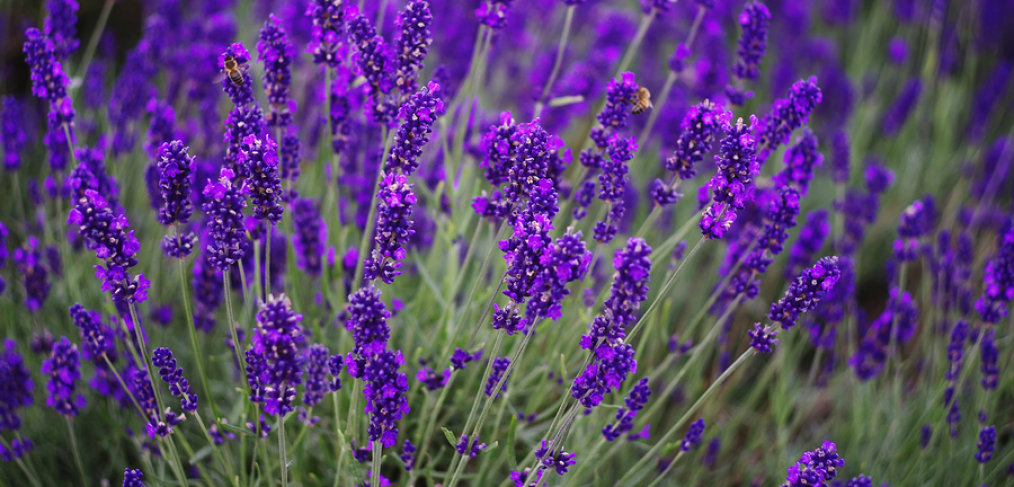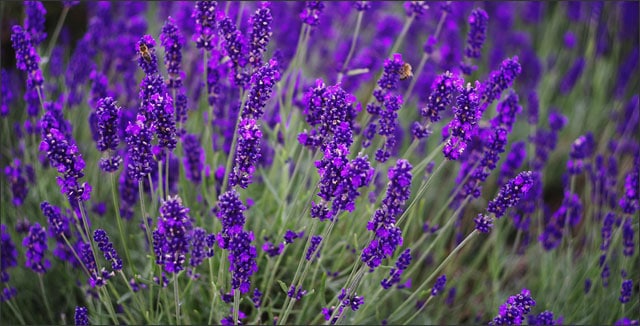
How to Grow Lavender Anywhere – Gardening Tips

Don’t you love the smell of lavender? There’s nothing better than a natural lavender scent to freshen clothing and linens or to invite a sense of relaxation into a room.
Almost better than the smell of fresh lavender is the sight of the bright purple herb dancing in the sunlight or bunched together and drying in someone’s cozy kitchen.
Did you know there are many uses for lavender, beyond sachets and bath salts?
The Amazing Diverse Uses of Lavender
Chefs in Provence, France – one of the most famous regions in the world for growing lavender and for its cuisine – commonly add this herb to a mixture you can find labeled “herbs de Provence.” It’s slightly bitter flavor is a beautiful addition to both sweet and savory foods – much like Rosemary.
Lavender also has antibacterial, antiviral, and antifungal properties, as well as anti-itch and anti-inflammatory. It has been used to help heal wounds, clean surfaces, treat bug bites and for aromatherapy in baths, tinctures, and diffusers.
Lavender1. works well for skin and hair care, especially for oily skin types. It can be drunk as a tea or added to many different foods. Lavender essential oil can be used to treat acne, hair loss, dry skin, dark eye circles, lice, dandruff, and wrinkles, among other things. The oil is pleasant to wear and tends to be calming and energizing at the same time.
The plant itself is a breeze to care for if you have the right conditions. It’s a very hardy plant which needs very little attention and craves lean soil. It’s drought resistant and pest resistant due to its strong scent and the essential oils it contains.
Lavender is both beautiful and sweet-smelling when growing, and it attracts plenty of pollinators to your garden.
Can You Grow Lavender Anywhere?
As with any plant, there are limitations to where it will thrive best. It’s important to keep in mind that lavender is native to the dry, moderate temperatures of western Mediterranean regions of the world, like Provence.
The lavender plant really likes heat, and it really dislikes water. So, if you live in a cold, humid climate, your chances of success with this plant will rely on which variety you plant and precautions you take to protect your plants.
Because of its popularity, lavender has been cultivated into numerous hybrids for specific climates all around the world. There are four common subgenres:
- 1. Lavandula angustifolia – English hybrids/true lavender
- 2. Lavandula stoechas – French hybrids
- 3. Lavandula dentata – Spanish hybrids
- 4. Lavandula multifida – Egyptian hybrids/fernleaf lavender
Special Considerations When You Grow Lavender
Southern Climates
If you live in a warm, southern climate, you will need to keep a few things in mind. Your summers will be longer and hotter than the typical climate lavender likes. In many southern climates, you will also have a good amount of humidity to combat.
Consider choosing a Lavandula dentata or stoechas variety, as it tends to thrive better in a hot, steamy climate.
To protect your plant from the most intense sun, make sure it gets planted where it will get partial shade in the late afternoon.
To combat the humidity, make sure your lavender plants have plenty of room to breathe! Don’t plant them too near each other or other plants. This will help keep your plant from humidity-related disease.
Northern Climates
For those gardeners who live in a cold, northern climate, you will be combating several factors which work against you when you grow lavender.
The first of these is the cold weather – sometimes extreme cold – that comes with northern winters. The other factor to consider in northern climates is heavy precipitation and saturated earth. These two problems alone can make trying to grow lavender in the north a challenge, but it’s not impossible! You may need some extra patience.
For growing lavender in northern climates, try these tactics:
- Use the subspecies Lavandula angustifolia – it’s a cold-hardy hybrid. Another variety to try is “Silver Mist” English lavender. It is hardy in zones 5-10 and has a beautiful silver color.
- Be prepared to grow smaller plants than what you’d typically find further south.
- Give your plants room to grow to combat humidity, and if you are planting in the ground, make sure you add drainage to combat soil saturation.
Some northern gardeners put their lavender in pots to bring inside when the weather gets cold. A south-facing window may provide your plant with enough sunlight to survive.
Alternately, you can try planting your lavender plants next to a south-facing brick or stone wall, which will soak up and radiate the sun’s heat during the winter.
How to Make Perfect Conditions for Your Lavender
When to Plant
When planting in the south where you are expecting a mild winter, you can plant your lavender plant in the fall. In the north, if you are planting in the ground, make sure to wait until the last frost date. Read below for more considerations for the typical wet spring weather in the north.
Drainage
Your first consideration, after combating the cold, is to make sure you provide proper drainage for your lavender plant.
Lavender loves heat and dry, lean soil. It will not tolerate excess moisture in the air or the ground, so you need to make sure the ground around your plant will drain.
If your soil isn’t sandy enough, you can dig a hole twice as deep as your root ball and add gravel to the bottom. Then, raise a mound up to two feet before planting your lavender plant. The hill will settle, but it helps to space plants out and keep them even drier.
Make sure any mulch you add will not hold in water. If you are planting in a cold climate, remember it’s often just best to plant in a container and move indoors when cold weather comes.
Space to Grow
Plan to space each plant as far from the next as it will grow tall. This way, each plant has plenty of room for air to circulate in the event of high humidity.
Alkaline Soil
It’s always a good idea to get your soil pH tested before planting, but for lavender it’s essential.
Lavender loves alkaline soil, so if yours is too acidic, you want to add lime and bone meal when planting. Add this to the ground once a year to make sure your plant stays happy.
A good rule of thumb is if you do not see the growth you’d like by the third or fourth year, re-test your soil to see if it needs to be amended.
Bringing it Home
Lavender is a beautiful, hardy, and useful plant for many applications. With the right species and considerations, you can grow and harvest this lovely herb for years to come!



